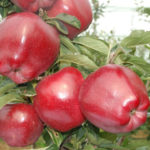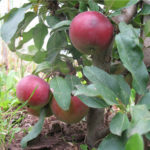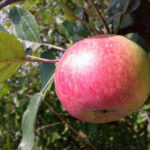Apple variety Rudolph (decorative)
Decorative apple trees are incredibly beautiful and multifunctional. They are a favorite element in landscape design, they are used as a bright accent to decorate slightly shaded corners of the garden, stately beauties are an excellent hedge that separates a residential building from a noisy street. In addition, the fruits of such a living decoration are quite suitable for processing. A worthy representative of this interesting group of plants is the Rudolph variety (named after the beloved cartoon character - the deer Rudolph, who differs from its relatives with a red glowing nose). By the beauty of flowering, our hero is not inferior to the famous Japanese sakuras. The origin of the variety is not exactly known, but Internet sources attribute it to European selection. It does not appear in the State Register of Breeding Achievements of Russia, but it is popular in many regions of the country due to its good winter hardiness.
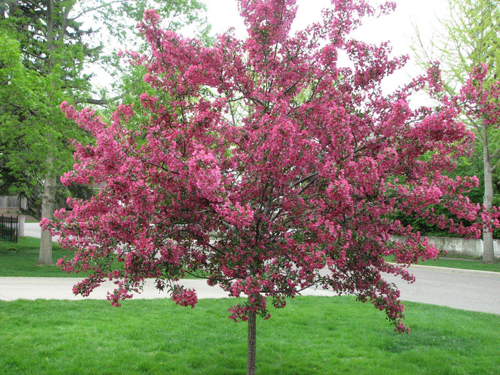
The peculiarity of this decorative apple tree is in its unusually spectacular appearance, which changes from spring to autumn and is beautiful in its own way in any of these periods. Each season the plant is colored differently. In the spring, you cannot take your eyes off the lush, pink-saturated bloom. In summer, you can enjoy the vibrant foliage that changes color throughout the season. Autumn will generously decorate the branches with colorful, small, but very cute apples.
Description
The tree is fast-growing at a young age, but at 6 - 7 years, active growth stops. The annual growth is about 50 - 70 cm. The apple tree is tall, stately, reaches a five-meter height, but sometimes it overcomes the seven-meter bar. At the request of the gardener, the variety can easily be shaped into a multi-stem shrub. The crown is lush, dense, pyramidal, but with age it acquires a rounded shape. Rudolph's crown diameter is about 4 meters. The bark of the trunk is dark gray-brown, which is called textured, rough, with longitudinal cracks that appear as the tree ages. Shoots grow vertically, the tops are directed upward, the bark is dark brown, smooth, the lentils are convex, oval, light brown.
The leaves are elongated-oval, or oblong-elliptical, with a pointed, slightly curving apex and a rounded-wedge-shaped base. The surface of the leaf blade is smooth, glossy, the edges are serrated, wide-wavy. The color of the apple tree leaf changes depending on its age. The young leaf is purple-red-brown, highly glossy. During the summer period, its color changes to a deep green, while the veins still have a bronze tint. In autumn, the leaf blade turns yellow, with red-pink edges. The petiole is long, thin, stained with anthocyanins.
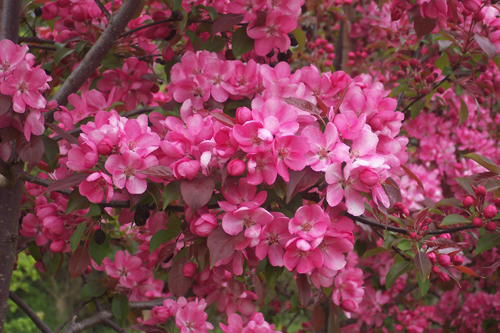
The decorativeness of the culture is manifested already in the spring, at the time of violent flowering, which occurs in May. There are a lot of flowers, because each inflorescence consists of 5 - 7 (or more) buds. When they unfold, they turn into real bouquets that cover the entire tree. Flowering branches are often used in floristic compositions. The flowers are rather large, cupped, five-petal, 3.0 - 4.5 cm in diameter. The petals are slightly elongated, with an oval apex. Each flower is painted in a rich pink color, which gradually brightens by the time of flowering. By the way, Rudolph's flowers are bisexual, so the variety is self-fertile, and even in a single planting, the apple tree will certainly delight with the harvest. Due to its abundant flowering, the plant is a reliable pollinator. The flowers are very fragrant and attract many bees. Pedicel is long, thin, colored.
Our hero belongs to the autumn varieties, at the end of August or the beginning of September, in place of the faded flowers, a decorative look ripens, but quite edible fruits. The apples are small, oval or ovoid, 2.5 cm in diameter. The surface of the fruit is smooth and glossy.The color is bright yellow-orange, a very beautiful reddish blush appears on the sunny side. The pulp is not very juicy, it tastes sweet and sour, with a well-perceived astringency. Apples stay on the branches for a surprisingly long time. They look especially impressive when covered with the first snow. The fruits begin to fall only when the air temperature drops below -4 ° C. The crop is often used for processing, such as making jam, jam or making cider. Naturally, the fruits of this apple tree, of course, can be eaten, but they are not popular as a dessert.
Variety characteristics
- Rudolph will show the first full bloom the next year after spring planting. The crop will form in the second year, however, full-fledged fruiting will occur only 4 - 5 years after planting;
- the yield from one tree is about 5 kg, which is not bad at all for an ornamental crop. At the same time, fruiting is stable, annual;
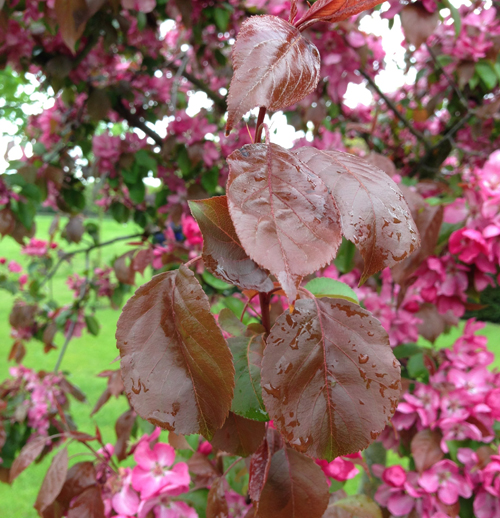
- our hero for about 15 years is able to show high decorativeness, and with good care he will delight at least another 5 years;
- a feature of the variety is its excellent endurance and the ability to grow in places that are unfavorable from the point of view of ecology, for example, on polluted city streets;
- frost resistance is very good, so the plant survives easily even in cooler regions. According to the system adopted by the US Department of Agriculture, the apple tree can grow without visible damage in USDA zones 4 to 7, with a minimum threshold for winter temperatures of -34.4 ° C;
- immunity is high. The plant is resistant to major crop diseases such as powdery mildew. Especially noteworthy is the high resistance to scab, due to which the elegant appearance of foliage and fruits does not suffer;
- but pests can cause many problems. Particular attention during the growing season should be paid to preventive treatments against aphids, spider mites, caterpillars;
- our hero is quite drought-resistant, thanks to a well-developed root system.
Planting and leaving
Growing a tree as spectacular as Rudolph is no big deal. But in order for the decorative qualities of the variety to manifest themselves as brightly as possible, you need to know a few rules. It is advisable to plant an apple tree in a well-lit area, the plant will cope with a small partial shade, but in a dense shade it will lose its beauty. Soils are desirable loose, well-drained, nutritious. If the soil on the site does not match, then you will have to prepare a planting hole, the size of which will be larger than usual, and fill it with a suitable soil mixture. Mandatory watering is needed only in the first years of growth; natural precipitation is enough for an adult plant. True, in the south, you still have to moisten the tree. Pruning is important to maintain decorativeness. Basically, a thinning procedure is required, due to which the flowering will be more abundant. In general, the variety is quite easy to form, therefore, if desired, the crown can be given a spherical single-barreled or multi-barreled standard shape.
Rudolph is an excellent solution for decorating any site. The plant can act as a decorative hedge that protects against dust and noise; it is planted in parks, squares, in group or single plantings. Thanks to its easy formation, it is possible to grow an apple tree even on a trellis. The variety has good winter hardiness, disease resistance. But first of all, gardeners are attracted to it by the decorative qualities that make them admire throughout the growing season. If you want to look for cons, they, perhaps, are not, well, except that the small weight of the fruit. But culture does not claim to be fruitful, it serves solely for decoration.
